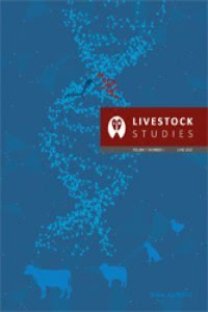Rasyon çinko miktarının boğalarda sperma miktar ve kalitesine etkisi
Özet: Araştırmada, hayvan materyali olarak, Hayvancılık Merkez Araştırma Enstitüsünde, dondurulmuş sperma üretimi yapılan 9 baş Siyah Alaca ırkı boğa kullanılmıştır. Araştırma, karma yemde 40 mg/kg çinko içeren kontrol grubu ve kontrol grubunda kullanan karma yeme ilave olarak 110mg/kg çinko (toplam 150 mg/kg Zn içeren 1. grup) ve 160 mg/kg (toplam 200 mg/kg Zn içeren 2. grup) çinko eklenen 3 farklı muamele grubundan oluşmuştur. Her gruba tesadüfi olarak 3er baş boğa dağıtılmıştır. Çinko preparatı olarak, kontrol grubu ve diğer iki muamele grubunda organik çinko bileşiği Bioplex Zinc (Aminoasit hidratin çinko şelat, Alltech) kullanılmıştır. Deneme başlangıcında, 60 gün ön yemleme yapılmıştır. Bu süre sonunda boğalardan suni vajen yöntemiyle 5 hafta boyunca, haftada 2 defa 2’şer ejakülat sperma alınmıştır. Sulandırılan spermalar, ekilibrasyondan sonra 0.25 ml’lik payetlere çekilerek, kontrollü dondurma cihazında dondurulup sıvı azot içinde saklanmıştır. Nativ spermatolojik değerlendirmeler aynı gün, çözüm sonu değerlendirmeleri ise 24 saatlik dondurma sürecinden sonra payetler 37°C’de 30 saniye süreyle çözdürülerek değerlendirilmiştir. Çalışmada sperma miktarı yönünden kontrol grubu ile 200 mg/kg çinko içeren 2. grup arasından fark önemsiz, kontrol grubu ile 150 mg/kg çinko içeren 1. grup arasındaki fark önemli (P<0.05) bulunmuştur. Motilite oranı, mass aktivite değeri ve yoğunluk yönünden kontrol grubu ile 1. ve 2. gruplar arasındaki fark önemli bulunmuştur (P<0.05). Sperma yoğunluğu bakımından en iyi sonuç 1. gruptan alınmıştır. Çözüm sonu en iyi motilite değeri ise 2. grupta elde edilmiştir. Damızlık boğaların beslenmesinde, karma yemde 40 mg/kg çinko (NRC 2001) kullanılması yerine, 150 veya 200 mg/ kg çinko kullanılmasının sperma miktarı ve kalitesi üzerine olumlu etki yaptığı kanaatine varılmıştır.
Effect of Diatery Zinc Level on Volume and Quality of Bull Semen
The project was conducted in Livestock Central Research Institute. In the experiment 9 head Holstein bulls were used as project material. Bulls were split into groups of three heads as one control (40 mg/kg) and 2 different levels of zinc groups (150 mg/kg, group 1; 200 mg/kg, group 2) randomly by drawing of lots. Bulls in the control group were fed with compound feed containing 40 mg/kg zinc and bulls in two other treatment groups were given additional 110 mg/kg (Group1) and 160 mg/kg (Group 2) zinc respectively. As zinc preparation in control and other two treatment groups, organic zinc compound, Bioplex Zinc (zinc chelate of amino acid hydrate by Alltech) was used. After 60 days of a preliminary feeding period, semen was collected as 2 ejaculates at each time in 2 times a week during 5 weeks. After dilution and equilibration, semen was filled into straws of 0.25 mL volume and frozen by controlled freezing device and stored in liquid nitrogen. Evaluation of native semen was carried out on the same day, and of frozen semen was done after the freezing procedure of 24 hours by thawing straws in 37°C for 30 seconds.With regard to semen volume, there were no differences between the control group and group 2 while the difference between group 1 and the control was significant (P <0.05). For motility and mass activity, differences were significant for either experimental groups (P<0.005). As for density, differences between control group and experimental groups were statistically significant and the best result was obtained from the group 1. The best result for after-thawing motility was obtained from the group 2. As a result, it may be deduced that compound feeds contain 150 mg/kg or 200 mg/kg zinc may be better for breeding bulls than compounds containing 40 mg/kg zinc which is recommended for breeding bulls by NRC 2001, but it still requires further investigations
